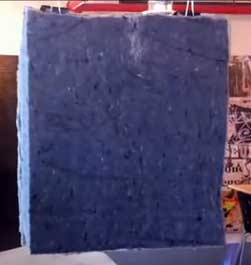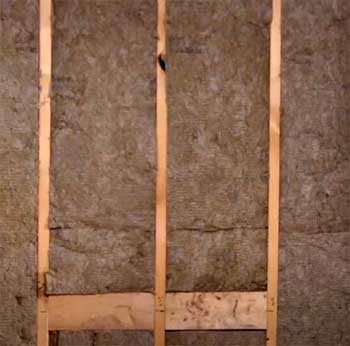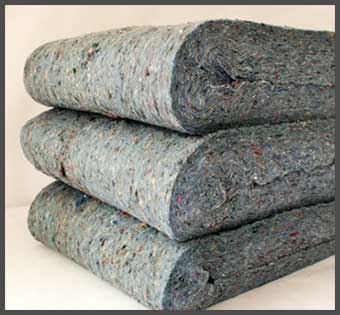When it comes to soundproofing your home, two of the most popular options are Quiet Batt and Rockwool insulation. But which one is better for reducing noise?
In this comprehensive guide, we’ll compare Quiet Batt and Rockwool to help you decide which insulation material is right for your soundproofing needs.
A Brief Comparison Table
| Feature | Quiet Batt | Rockwool |
| Material | Fiberglass | Stone wool |
| Density | 4 – 8 lb/ft3 | 4 – 8 lb/ft3 |
| Fire Resistance | Low. Requires ignition barrier | Excellent. Non-combustible |
| Mold Resistance | Good with hydrophobic treatment | Excellent |
| Sound Absorption | Excellent | Excellent |
| Noise Reduction | Equal when thickness and density are equal | Equal when thickness and density are equal |
| Environmental Impact | Fair. Contains recycled glass | Good. High recycled content, less energy intensive production |
| Ease of Installation | Easy. Cuts with knife. | Moderate. Requires special blades. |
| Best Uses | Interior walls, ceilings, floors, home theaters | Exterior walls, fire-rated assemblies, damp areas |
Overview of Quiet Batt and Rockwool
First, let’s start with an overview of each insulation material:
What is Quiet Batt Insulation?

Quiet Batt is a type of fiberglass insulation specifically designed for soundproofing.
It consists of heavy densities of fiberglass batts, often 4 pounds per square foot or higher.
The heavy density absorbs sound vibrations rather than transmitting them through walls, floors, and ceilings.
Quiet Batt comes in various thicknesses, typically ranging from 3-8 inches thick.
Key features of Quiet Batt:
- Made of fiberglass
- Available in high density 4 lbs/sq ft and up
- R-13 to R-30 insulation values
- Thick batts 3″ to 8″ thick
- Absorbs sound for noise reduction
What is Rockwool Insulation?
Rockwool is a type of stone wool insulation made from basalt rock and recycled slag. It contains dense fibers that dampen sound vibrations. Roxul is a common brand name for stone wool insulation. Rockwool comes in rigid boards and semi-rigid batts. Popular thicknesses range from 2-6 inches.
Key features of Rockwool:
- Made of natural stone and recycled slag
- High density fibers resist sound transmission
- Available in boards and batts
- R-10 to R-24 insulation values
- Fire resistant and repels moisture
- Can be used for thermal and/or acoustical insulation
Key Differences Between Quiet Batt And Rockwool For Soundproofing

Now that we’ve got the basics down, let’s compare these two insulation materials head-to-head.
Soundproofing Ability
First and foremost, we need to look at the sound dampening capabilities of Quiet Batt versus Rockwool. There are a few key factors that determine performance:
- Density – Higher density materials resist sound transmission better. Rockwool has a slightly higher density than most Quiet Batts.
- Thickness – Thicker insulation blocks more noise. Both come in various thicknesses from 2″ up to 8″.
- Sound Absorption – Absorptive materials dampen echoes and reverberation. Rockwool and high density Quiet Batts have excellent sound absorption properties.
Numerous tests by independent labs have verified that high density Quiet Batt and Rockwool provide similar noise reduction performance, when comparing products of equivalent thickness and density. Many experts consider them equal for soundproofing ability.
In real-world usage, thickness is often more important than the insulation material itself. The thicker the insulation, the higher the noise reduction it provides. 8″ of either Quiet Batt or Rockwool will block more sound than 3″ of the same product.
Verdict: Draw for Soundproofing Ability
When used in similar thicknesses and densities, Quiet Batt and Rockwool provide very comparable noise blocking. For maximum soundproofing, choose the thickest, highest density product within your budget.
Fire Resistance
An important factor for insulation materials is fire resistance. How do Quiet Batt and Rockwool compare for fire safety?
Fiberglass insulation like Quiet Batt has an inherent fire hazard. The binder used in fiberglass batts is combustible at high temperatures. Building and fire codes require covering exposed fiberglass in occupied spaces.
Rockwool is intrinsically fire resistant. It can withstand temperatures up to 2150°F. Rockwool received the highest fire rating of Non-Combustible per ASTM E136. It does not require additional ignition barriers. This makes it ideal for interior wall soundproofing.
Verdict: Rockwool is More Fire Resistant
Due to its non-combustible stone composition, Rockwool is a safer choice where fire resistance is a key factor. Fiberglass Quiet Batt requires additional coverings for fire code compliance in exposed installations.
Moisture & Mold Resistance

Preventing moisture accumulation and mold growth is important for insulations.
Dampness can compromise acoustic performance and indoor air quality.
How do Rockwool and Quiet Batt handle humidity and moisture?
Fiberglass insulation can potentially absorb moisture and sustain mold growth if exposed.
However, Quiet Batt includes a hydrophobic additive that repels water.
This enhances its moisture resistance. If installed correctly in dry conditions, Quiet Batt remains mold-free.
Rockwool’s dense fibers naturally resist moisture intrusion and propagation. It retains its insulation value and sound absorption when damp. Rockwool’s composition prevents microbial growth.
Independent lab testing verifies no detectable mold growth occurs in Rockwool, even after months of exposure to hot, humid conditions. For extremely damp spaces, Rockwool may have a slight edge.
Verdict: Rockwool is Slightly Better for Mold Resistance
Both insulations resist moisture accumulation and mold with proper installation. Under prolonged damp conditions, Rockwool maintains its acoustic performance better while inhibiting microbial growth.
Cost Comparison
Let’s now look at cost differences between these two insulation materials. The price per square foot can vary based on factors like:
- Thickness – Thicker batts or boards cost more
- Density – Higher density products are more expensive
- Brand – Major brands like Roxul tend to cost more
- Supplier – Retail vs online vendor pricing varies
Typical price per square foot installed:
- Basic fiberglass batts – $0.35 – $1.50 psf
- High density Quiet Batt – $1.25 – $2.50 psf
- Rockwool batts – $1.50 – $3 psf
- Rockwool Soundproofing Board – $2 – $4 psf
Total cost for 12′ x 15′ room with R13 insulation:
- Fiberglass: $630
- Quiet Batt: $1,350
- Rockwool Batts: $1,620
- Rockwool Boards: $2,160
The denser materials with better sound blocking do come at a higher price point. Basic fiberglass can be twice as cheap but provides less noise reduction.
For a comparable thickness and acoustic rating, Quiet Batt is generally 10-20% cheaper than Rockwool. But for complete fire safety, the extra cost of Rockwool may be warranted.
Verdict: Quiet Batt is More Budget Friendly Overall
Fiberglass Quiet Batt provides significant savings over Rockwool, while still delivering excellent noise blocking. It gives superior value for cost-conscious consumers.
Environmental Impact
Many homeowners and builders also consider the environmental impact of insulation materials. What are the differences between Rockwool vs. Quiet Batt?
Fiberglass insulation contains 30-60% recycled glass content. However, some binders and formaldehyde-free treatments do contain VOC’s. Fiberglass requires high energy consumption to produce.
Rockwool contains up to 70% recycled content from slag and rocks. It also utilizes some binders in production. But Rockwool is more energy efficient to manufacture and contains no added formaldehyde.
Both companies have initiatives to reduce their environmental footprint. But overall, Rockwool has a slight green advantage.
Verdict: Rockwool is Slightly More Sustainable
With higher recycled content and more energy-efficient production, Rockwool is a greener insulation product. But Quiet Batt and modern fiberglass also include recycled materials and combat VOC offgassing.
Soundproofing Uses
Where can you use Rockwool vs. Quiet Batt soundproofing? Let’s look at the best applications for each insulation type:
Ideal Uses for Quiet Batt:

- Interior wall soundproofing between rooms
- Floor underlayment beneath hard surfaces
- Ceiling insulation above living spaces
- HVAC duct insulation
- Home theaters, media rooms
Ideal Uses for Rockwool:
- Interior wall soundproofing with fire safety
- Exterior wall insulation
- Floor soundproofing between stories
- Theater stages, music studios
- Mechanical room sound absorption
Both work well for most soundproofing projects. Fiberglass Quiet Batt offers cost-effective, basic noise reduction in living areas. Rockwool provides maximum fire safety and dampness resistance ideal for music or utility spaces.
Verdict: Both Have Unique Soundproofing Applications
Quiet Batt suits budget home soundproofing needs in most dry areas. Rockwoel excels for fire-rated assemblies, exterior walls, below-gradedampness protection, and studios/stages needing acoustic treatments.
Ease of Installation
Let’s quickly compare how easy Quiet Batt and Rockwool are to install:
- Cutting – Fiberglass is easier to cut cleanly using a utility knife. Rockwool requires a serrated blade or electric carving knife.
- Itch factor – Fiberglass can be irritating when handling. Rockwool generally doesn’t irritate skin.
- Fitting – Both insulations are compressible and can fill voids. Rockwool boards are more rigid and need careful fitting.
- Weight – Stone wool is heavier and can be trickier to install overhead.
Overall, fiberglass Quiet Batt ranks easier to measure, cut, and install. But Rockwool isn’t too difficult for DIYers to work with using the right tools. The rigid boards take some experience.
Verdict: Quiet Batt is Slightly More DIY-Friendly
With good gloves and blades, Rockwool isn’t overly challenging to install. But fiberglass Quiet Batt generally wins for simpler cutting, fitting, and less skin irritation.
Soundproofing FAQ
Looking for quick answers to common questions about soundproofing with Quiet Batt and Rockwool? Here are the key facts:
Rockwool and high density Quiet Batt provide nearly equal sound blocking when used in the same thickness. Thickness has the biggest impact on noise reduction.
The best soundproofing batts have a density of at least 4 pounds per square foot. Top choices are Roxul Safe’n’Sound, Quiet Batt, and Insul-Shield 100. 3-4 inches provides decent soundproofing.
Fiberglass Quiet Batt provides impressive noise reduction at 20-50% lower cost than Rockwool depending on thickness. It lacks fire resistance but excels at taming noise on a budget.
Quiet Batt is a heavy, dense fiberglass insulation rated at 4-8 lbs/ft3 density. It blocks sound transmission through walls, ceilings and floors in a cost-effective way. Quiet Batt works well for home soundproofing projects and home theaters.
The Verdict: It Depends on Your Needs
When choosing between Quiet Batt and Rockwool soundproofing insulation, there’s no universally “best” option. The right product for you depends on your specific needs and project details.
Here are some quick recommendations based on common soundproofing goals:
- On a tight budget – Go with fiberglass Quiet Batt.
- Fire safety is critical – Choose non-combustible Rockwool.
- Concerned about moisture issues – Rockwool resists dampness better.
- Soundproofing below-grade areas – Rockwool excels.
- Basic noise reduction for rooms – Quiet Batt provides solid value.
- Recording studios and theaters – Rockwool is ideal.
For many homeowners’ needs, inexpensive Quiet Batt offers lots of acoustic bang for your buck. The denser insulation and fireproof nature of Rockwool justify the higher costs for the right applications.
No matter which you choose, proper installation is key to maximize noise blocking. Follow manufacturer guidelines on thickness and correct sealing for optimum soundproofing results.
Now you have a detailed comparison of the pros, cons, costs, and best uses for Quiet Batt vs. Rockwool soundproofing. Make an informed decision to pick the right insulation for your specific noise reduction and budget needs.

Interesting article I am wondering if the cost of going from 3 1/2″ Quiet Batt to a 6″ Quiet Batt for ceiling area below living space is worth the extra cost.